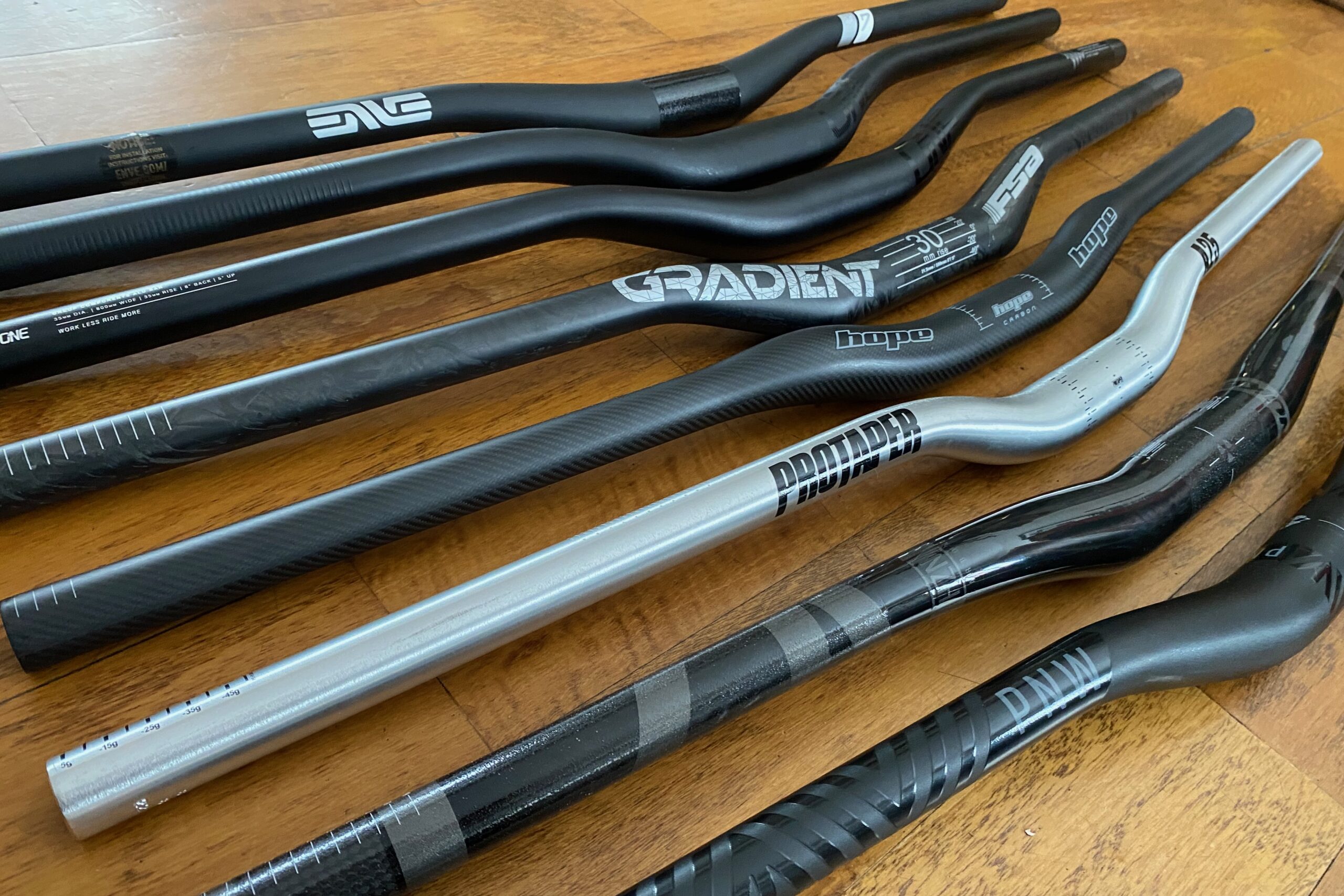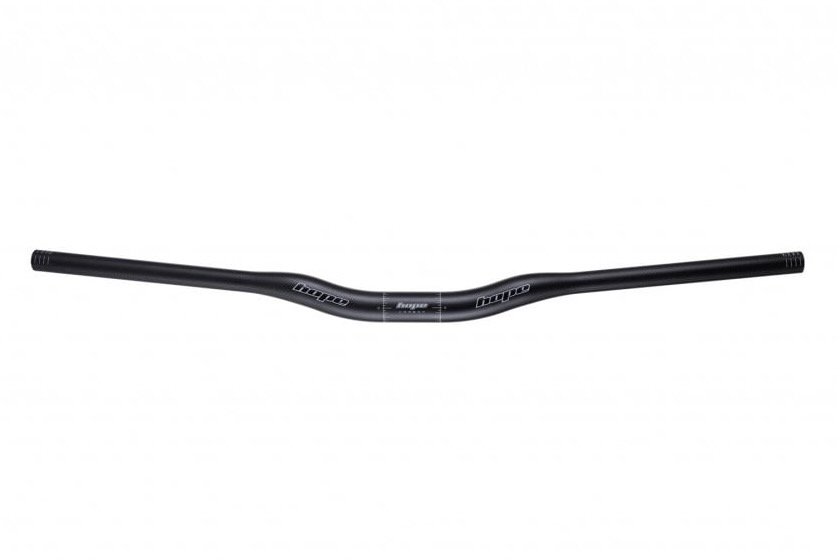Your mountain bike handlebar is an often-overlooked component that can transform the way your bike handles and feels. As the primary handling interface of your bike, your handlebar is critical not only for control but can have a significant impact on your comfort as well.
While mountain bike handlebars all look relatively similar, there are some pretty significant differences among the myriad options on the market. Working with modern materials and construction methods, brands have been able to design handlebars with different performance characteristics to suit just about every need and preference, and that’s a great thing. It turns out that the handlebar is, in fact, a performance component that can provide varying benefits, whether you’re seeking something stiff and precise, compliant and forgiving, or if you’re trying to lighten up your ride or dial in the fit of your cockpit.
These days, there are so many different mountain bike handlebars on the market it could make your head spin. Made from materials ranging from carbon fiber to aluminum – even titanium, coming in 31.8mm and 35mm clamp sizes, and a whole range of different rise and sweep options, it can be hard to figure out which is the best handlebar for you. It doesn’t help that every handlebar is claimed to be the best for (insert adjective here) by their respective manufacturers. So how do you choose the right one?
Last year, we teamed up with Faction Bike Studio to do a first-of-its-kind group compliance test of 42 different handlebars in their lab, followed by rider testing to see how those findings translated to use out on the trail. Armed with the information gathered during lab and rider testing, along with months of testing the bars included here in the real world, we’ve got recommendations to suit every need and budget.
Our favorite mountain bike handlebars are listed below, along with the best of the rest which are also great options worthy of serious consideration. Our handy comparison chart shows all of the models we tested and their specs at a glance. Our detailed buying advice has all the information if you need help deciding what you need, followed by our FAQ section with answers to common questions.
The Best Mountain Bike Handlebars of 2024
- Best Overall Carbon Mountain Bike Handlebar: OneUp Components Carbon Handlebar
- Best Value Carbon Mountain Bike Handlebar: FSA Gradient Carbon
- Best Overall Aluminum Handlebar: OneUp Components Aluminum Handlebar
- Best Value Aluminum Mountain Bike Handlebar: PNW Components Range Gen 3
- Best Mountain Bike Handlebar for Compliance: Roost Titanium Riser
- Best Mountain Bike Handlebar for XC Riding and Racing: Race Face Next SL Carbon
- Best Mountain Bike Handlebar for More Back Sweep: SQlab 30X Carbon Handlebar
OneUp Components Carbon Handlebar
Specs
- MSRP $160
- Material Carbon fiber
- Measured Weight 228g (20mm rise)
- Width 800mm
- Clamp Diameter 35mm
- Rise Options 20mm (tested), 35mm
- Sweep 8° back, 5° up

Pros
- Fair price for carbon
- Lightweight
- Gret vibration dampening
- Well balanced compliance and responsiveness
Cons
- None
FSA Gradient Carbon Riser 30
Specs
- MSRP $146
- Material Carbon
- Measured Weight 237g (31.8mm clamp, 30mm rise)
- Width 800mm
- Clamp Diameter 31.8mm (35mm also available)
- Rise Options 20mm, 30mm (tested)
- Sweep 8° back, 5° up

Pros
- Reasonably priced for carbon
- Lightweight
- Great middle-of-the road compliance (other sizes are much stiffer)
- Available in both clamp diameters
Cons
- Pretty loud branding
- Other sizes tested much stiffer
OneUp Components Aluminum Handlebar
Specs
- MSRP $90
- Material Aluminum
- Measured Weight 342g (35mm rise)
- Width 800mm
- Clamp Diameter 35mm
- Rise Options 20mm, 35mm (tested)
- Sweep 8° back, 5° up

Pros
- Slightly more compliant than the carbon version
- Less expensive than carbon
- Sold in bundles with stem, grips, and decals
Cons
- Heavier weight
- Doesn't mute vibration as well as the carbon version
PNW Components Range Gen 3
Specs
- MSRP $$69 (31.8mm) – $74 (35mm)
- Material Alloy
- Measured Weight 309g (35mm clamp)
- Width 800mm
- Clamp Diameter 35mm (31.8mm also available)
- Rise Options 30mm
- Sweep 10° back, 5° up
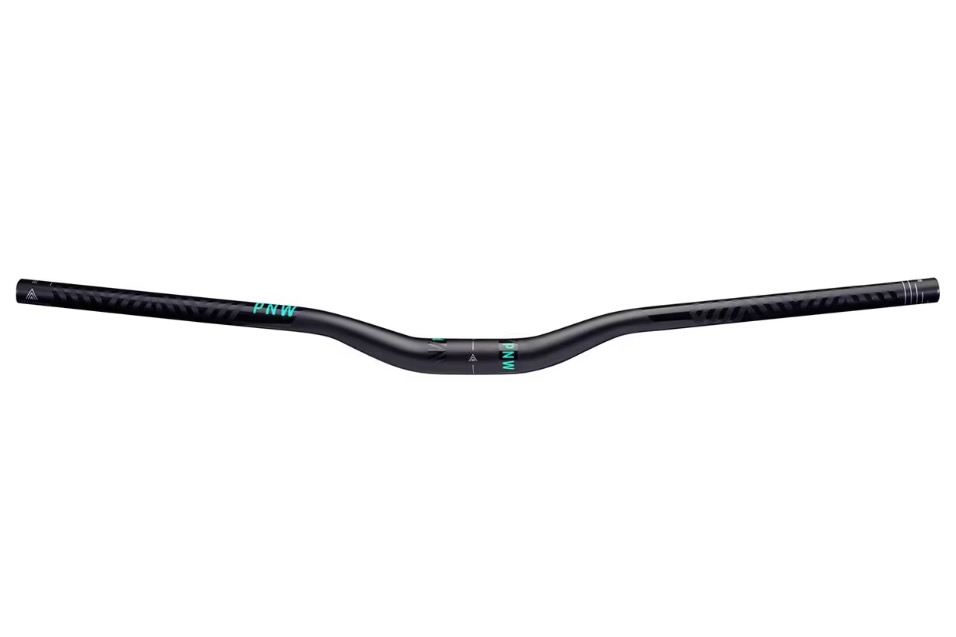
Pros
- Affordable
- Comes in both clamp diameters (31.8 is more compliant)
- Comfortable, balanced feel
- 4 graphic color options
Cons
- Heavier than carbon
- Only one rise option – 30mm
- Measure a tad wider than 800mm
Roost Titanium Riser Handlebar
Specs
- MSRP $295
- Material Titanium
- Measured Weight 303g (30mm rise)
- Width 800mm
- Clamp Diameter 31.8mm
- Rise Options Flat, 20mm, 30mm (tested)
- Sweep 9° back, 5° up
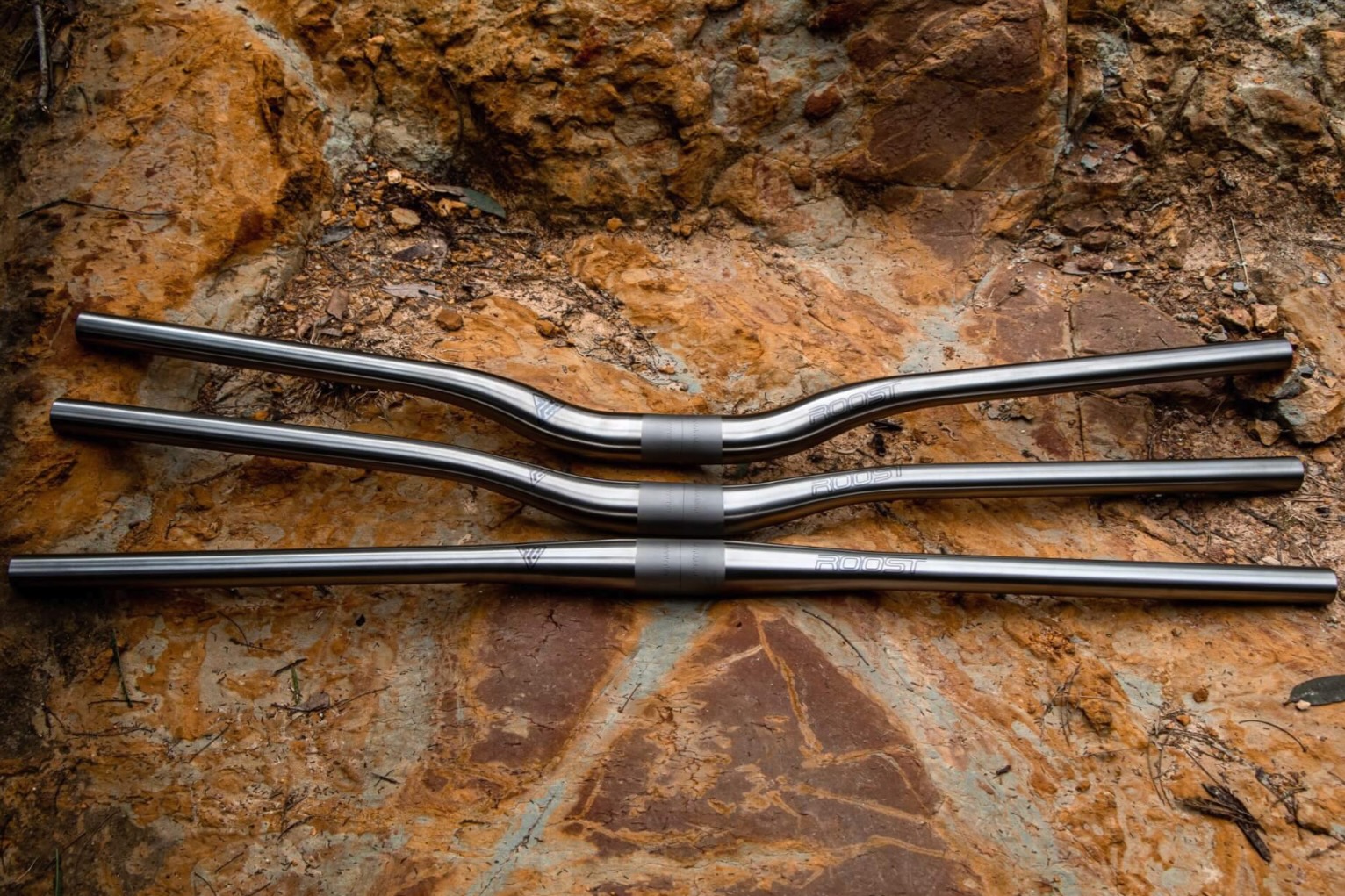
Pros
- The most compliant – comfortable on the hands
- Raw Titanium look is sweet
- Claimed to be exceptionally durable
Cons
- Expensive
- Heavier than carbon
Race Face Next SL Carbon
Specs
- MSRP $180
- Material Carbon
- Measured Weight 167g
- Width 740mm
- Clamp Diameter 35mm
- Rise Options 10mm
- Sweep 8° back, 5° back
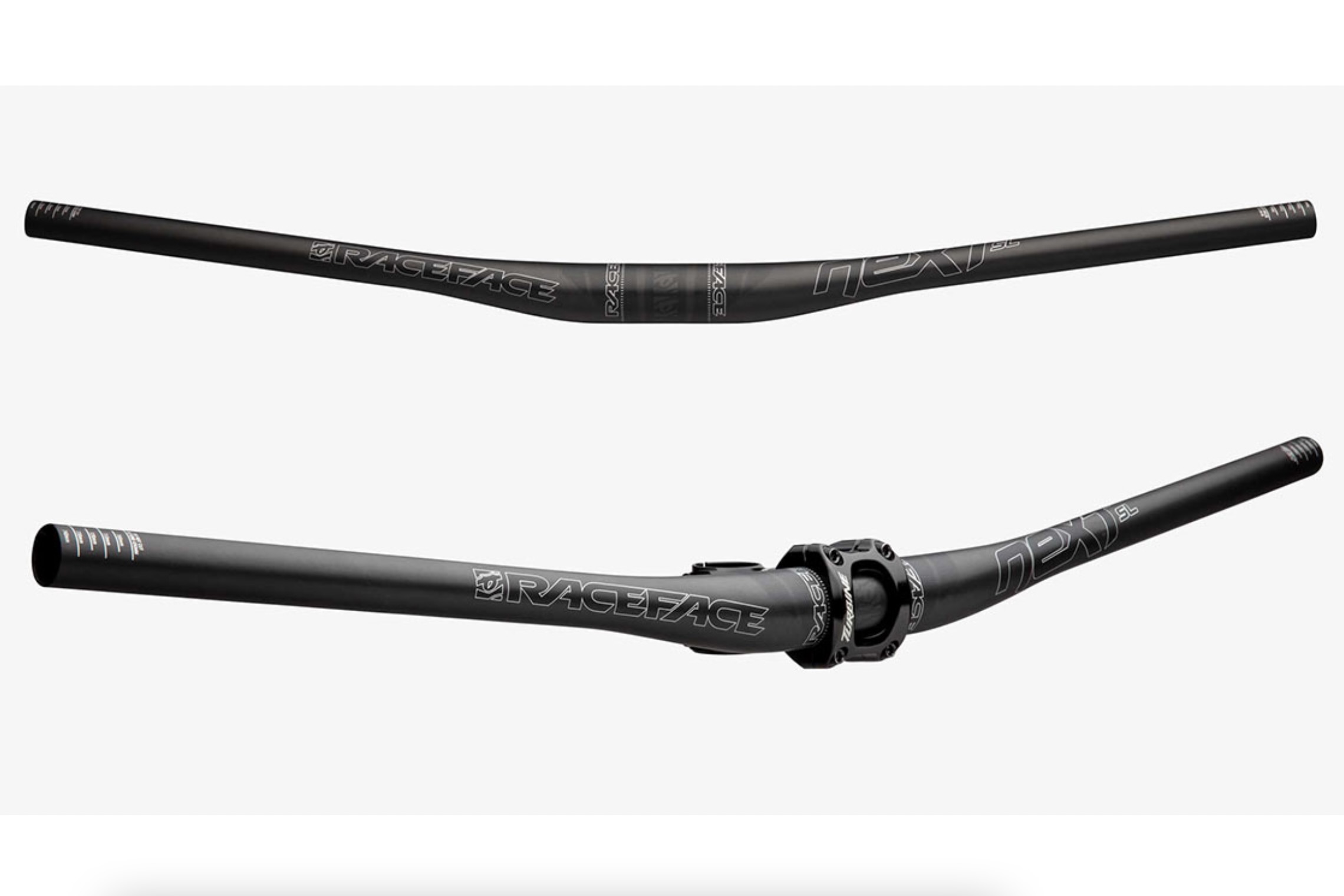
Pros
- Super light
- Stiff and precise
- Surprisingly forgiving on the hands
- Perfect size and weight for XC bikes
Cons
- 740mm width may be too narrow for some riders
SQlab 30X Carbon
Specs
- MSRP $320
- Material Carbon (also comes in aluminum)
- Measured Weight 240g (45mm rise)
- Width 780mm
- Clamp Diameter 31.8mm
- Rise Options 15mm, 30mm, 45mm (tested)
- Sweep 12° or 16° back, 4° up

Pros
- 12 or 16-degree options for those seeking more back sweep than most standard bars offer
- Lightweight
- 3 rise options
- Stiff but not overly harsh
- Comes in aluminum version that costs less than half
Cons
- Very expensive
- Extra back sweep won't be for everyone
- SQlab measures rise differently than other brands
Best of the Rest
Nukeproof Horizon V2 Carbon
Specs
- MSRP $150
- Material Carbon
- Measured Weight 258g (25mm)
- Width 800mm (780mm also available)
- Clamp Diameter 35mm (31.8mm also available)
- Rise Options 12mm, 25mm (tested), 38mm
- Sweep 9° back, 5° up

Pros
- Fair price for carbon
- Stiff and precise
- Available in both clamp diameters and 2 widths
- Three rise options
Cons
- A little heavier than other carbon options
- Less forgiving than other carbon models tested
Chromag BZA
Specs
- MSRP $200
- Material Carbon fiber
- Measured Weight 230g (25mm rise)
- Width 800mm
- Clamp Diameter 35mm
- Rise Options 15mm, 25mm (tested), 35mm
- Sweep 9° back, 5° up
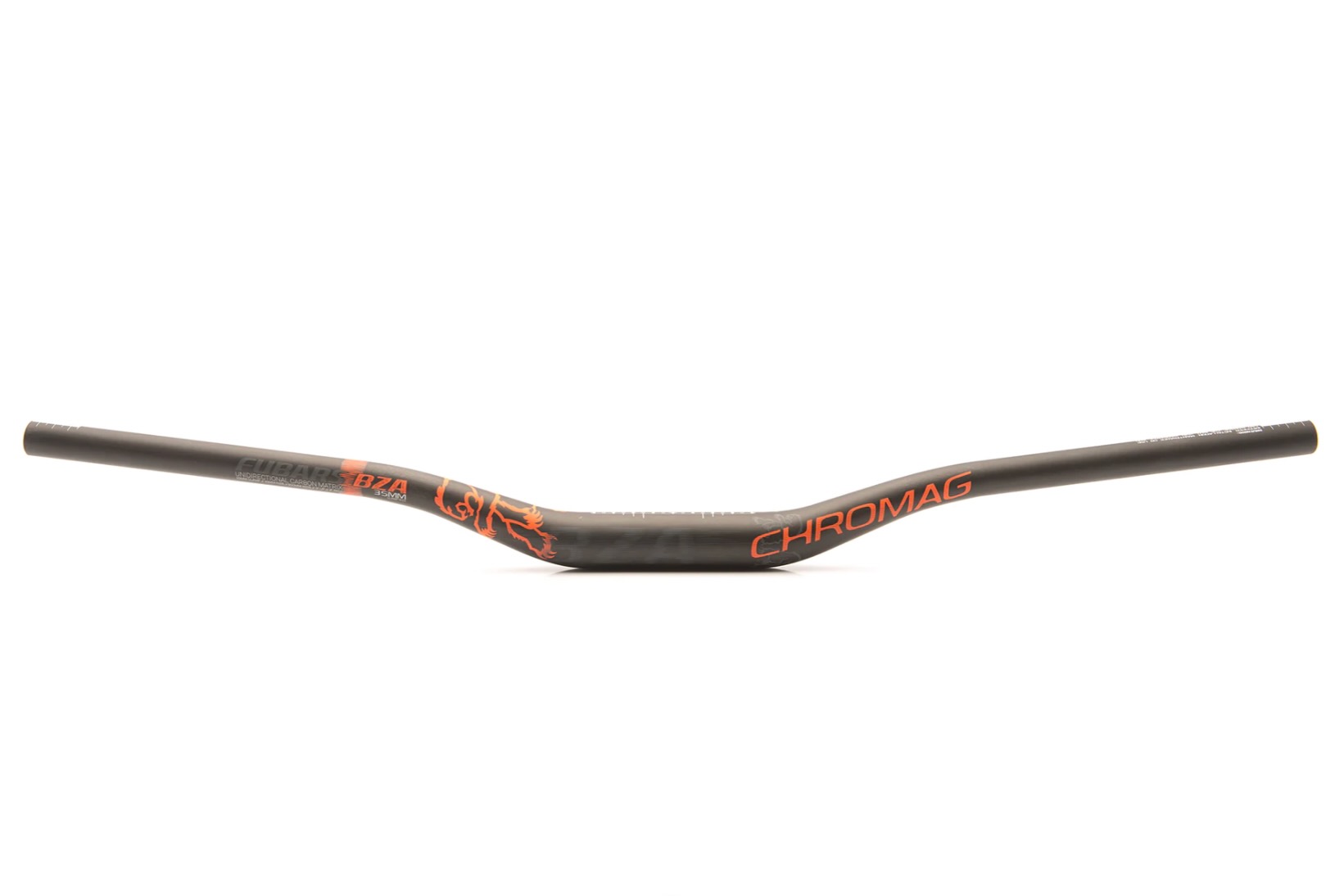
Pros
- Precise handling
- Lightweight
- Looks great
- Available in 3 rise options
Cons
- Not quite as compliant as some
- Fairly expensive
ENVE M7
Specs
- MSRP $190
- Material Carbon
- Measured Weight 243g (25mm rise)
- Width 800mm
- Clamp Diameter 35mm
- Rise Options 10mm, 25mm (tested), 40mm
- Sweep 8° back, 4° up

Pros
- Classy looks
- Precise handling
- 3 rise options
- Comes with decal sheet for color matching to wheels
Cons
- Expensive
- Doesn't mute feedback quite as well as some other carbon options
ProTaper A25 Aluminum Handlebar
Specs
- MSRP $105
- Material Alloy
- Measured Weight 317g (31.8mm clamp, 25mm rise)
- Width 810mm
- Clamp Diameter 31.8mm (35mm also available)
- Rise Options 12mm, 25mm (tested), 38mm, 50mm
- Sweep 8° back, 4° up

Pros
- Very compliant
- Almost as compliant as Titanium at roughly 1/3 the price
- 3 finish options available – silver looks great
- 4 rise options and comes in both clamp diameters
Cons
- Moderately expensive for aluminum
- Heavier weight
Comparison Chart
| Handlebar Model | MSRP | Material | Weight (size tested) | Width | Clamp Diameter | Rise Options | Sweep | Stiffness Rating (lbs/in) |
|---|---|---|---|---|---|---|---|---|
| OneUp Components Carbon | $160 | Carbon | 228g (20mm rise) | 800mm | 35mm | 20mm, 35mm | 8° back, 5°up | 371 |
| FSA Gradient Carbon | $146.60 | Carbon | 237g (31.8 clamp/30mm rise) | 800mm | 31.8mm, 35mm | 20mm, 30mm | 8° back, 5°up | 388 |
| OneUp Components Aluminum | $90 | Aluminum | 342g (35mm rise) | 800mm | 35mm | 20mm, 35mm | 8° back, 5°up | 351 |
| PNW Range Gen 3 | $69 – $74 | Aluminum | 309g (35mm clamp) | 800mm | 31.8mm, 35mm | 30mm | 10° back, 5°up | 409 |
| Roost Titanium Riser | $295 | Titanium | 303g (30mm rise) | 800mm | 31.8mm | Flat, 20mm, 30mm | 9° back, 5°up | 264 |
| Race Face Next SL Carbon | $180 | Carbon | 167g | 740mm | 35mm | 10mm | 8° back, 5°up | 8° back, 5°up |
| SQlab 30x Carbon Handlebar | $320 | Carbon | 240g (45mm rise) | 780mm | 31.8mm | 15mm, 30mm, 45mm | 12° or 16° back, 4° up | not lab tested |
| Hope Carbon Handlebar | $215 | Carbon | 222g (31.8 clamp/20mm rise) | 800mm | 31.8mm, 35mm | 20mm | 7° back, 5°up | 355 |
| Nukeproof Horizon V2 Carbon | $150 | Carbon | 258 g (25mm rise) | 780 or 800mm | 31.8mm, 35mm | 12mm, 25mm, 38mm | 9° back, 5°up | 451 |
| Chromag BZA | $200 | Carbon | 230g (25mm rise) | 800mm | 35mm | 15mm, 25mm, 35mm | 9° back, 5°up | 409 |
| ENVE M7 Handlebar | $190 | Carbon | 243g (25mm rise) | 800mm | 35mm | 10mm, 25mm, 40mm | 8° back, 4°up | 388 |
| ProTaper A25 Aluminum | $109 | Aluminum | 317g (25mm rise) | 810mm | 31.8mm, 35mm | 12mm, 25mm, 38mm, 50mm | 8° back, 4°up | 299 |
Why You Should Trust Us
To say that the team at Bikerumor is gear-obsessed would be an understatement. Writing about cycling gear is more than just a job, riding bikes is also our passion, and we’re always on the hunt for products that can improve our experience out on the trails. Over the years, we learned that even a component as seemingly simple as the handlebar can enhance our comfort and control while mountain biking. And, we’ve been fortunate to test out lots of different handlebars to find what we like best. Still, there are so many handlebars on the market with various claims about their performance characteristics, that it can be tricky to find the perfect handlebar for you.
To learn more, we teamed up with Faction Bike Studio to do compliance testing in their lab to get some real data on the stiffness and compliance of 42 different handlebars. Then, we rider-tested a selection of those handlebars to see if the differences in stiffness/compliance were noticeable on the trail and what impact it had on our comfort and control. We found that there are notable differences among the bars we tested and that the lab findings lined up with the rider experience. Review author, Jeremy Benson, was one of the test riders for the handlebar testing project. As someone who has struggled with numb hands and arm pump while riding, Jeremy has spent years searching for the perfect handlebar that provides the ideal balance of forgiveness and responsiveness, and he has tried over 30 different models in the past few years.
We started our testing by gathering 42 handlebars and having them sent to Faction Bike Studio in Granby, Quebec for compliance testing in their lab. Each handlebar was put through the same compliance test to measure the deflection, or flex, under a predetermined amount of weight applied. These numbers gave us data to compare the handlebars in terms of stiffness and compliance, as there is otherwise no standard rating system or scale. After the lab testing, we chose 4 models for rider testing, and you can check out this article and the accompanying video to see how we tested and what we learned. In addition to testing the handlebars in the lab and on the trail for our video project, Jeremy tested all twelve of the handlebars included in this buyer’s guide to get a feel for how each model performs out on the trail. Our recommendations are based on his real-world testing experience and are informed by the results of the Faction Bike Studio lab testing.


Buying Advice: How to Choose Mountain Bike Handlebars
For such a seemingly simple component, there is a surprising amount to consider when choosing a new mountain bike handlebar. In the following sections, we’ll discuss important factors like different materials, geometries, stiffness/compliance, weight, and more to help you wade through the multitude of options on the market if you’re looking for something new.
Material
The two materials that are most commonly used in mountain bike handlebars are carbon fiber and aluminum. In many cases, some brands even make the same handlebar in both options. There are also a small handful of handlebars made from Titanium on the market these days. One of the primary factors that differentiates these materials is price, but there are other differences we’ll cover below.

Carbon Fiber
Carbon fiber is widely used in the construction of mountain bike handlebars because it has an excellent strength-to-weight ratio and it can be manipulated into different shapes and layups to tune them to produce desired performance characteristics, particularly in regards to stiffness/compliance. One of the primary benefits of carbon handlebars for many riders is that they are dramatically lighter than their aluminum counterparts, often weighing in the neighborhood of 70 to 100 grams less (depending on the models in question). While that may not matter to everyone, it is one of the more cost-effective ways to shave that much weight off a complete bike. Additionally, carbon fiber has a good ability to absorb high-frequency vibration, comparatively speaking.
It is worth noting that in the compliance (flex) testing at the Faction Bike Studio lab, the average stiffness of the carbon handlebars we tested was slightly higher than the aluminum competition. Of course, that is an average taken from our sample of handlebars and doesn’t tell the whole story, particularly given carbon’s vibration-absorbing properties. In fact, we’d argue that most of the carbon handlebars in the middle of the stiffness compliance spectrum actually do a better job of dampening vibration and muting feedback than similarly compliant bars made from aluminum.
The primary drawback to carbon fiber as a handlebar material is that it has a higher manufacturing cost that results in prices that can be as much as double, or more, than an equivalent aluminum option. And, while carbon fiber handlebars are incredibly strong, they can be more prone to damage from blunt impacts, crashes, or possibly even the over-tightening of stem bolts or bar clamps for your controls. We always recommend using a torque wrench when tightening anything on your bike, particularly when dealing with carbon components.
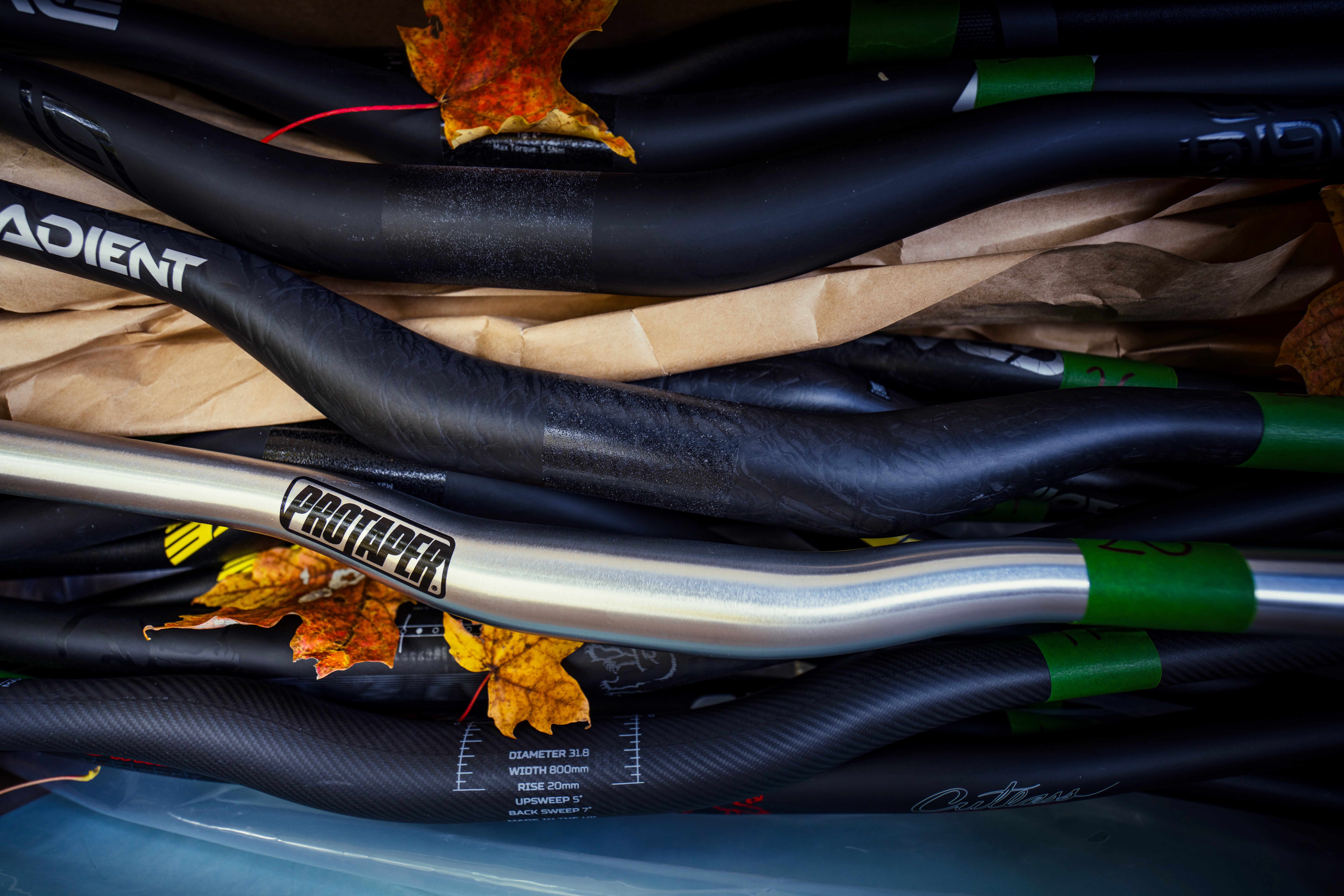
Aluminum
Before the industry-wide adoption of carbon fiber as a material for use in the construction of just about everything, aluminum was just about the only game in town for mountain bike handlebars. Comparatively speaking, aluminum is less expensive as a material, and producing components like frames and handlebars is easier and therefore less costly. Still, it can be manipulated into a wide array of shapes and sizes, although it is a bit more limited in terms of tunability compared to carbon fiber. And, while it is fairly lightweight, aluminum handlebars almost always weigh quite a bit more than their carbon counterparts.
The results of the Faction Bike Studio compliance testing in the lab showed us that, on average, aluminum handlebars are slightly more compliant than their carbon counterparts. That is a very broad generalization of course, as some aluminum bars are super stiff, but overall, aluminum bars are a bit more forgiving in terms of stiffness. That said, beyond the flex of an aluminum handlebar, the material itself doesn’t absorb vibration quite as readily as carbon fiber, in our experience.
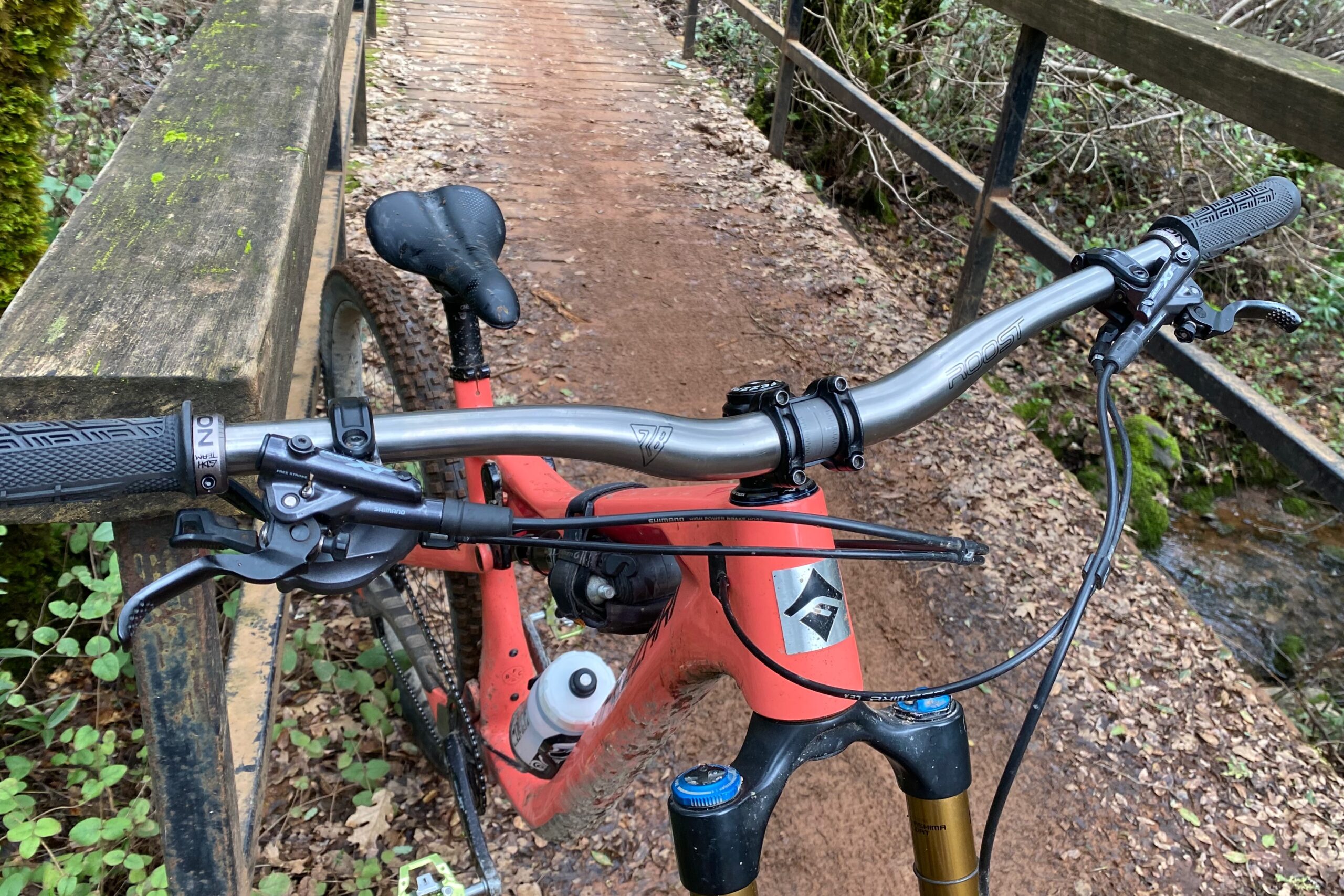
Titanium
Titanium is the least common material used in mountain bike handlebars, but brands have been making frames and handlebars out of it for many decades. In fact, I have a super narrow Bontrager Titec handlebar on my vintage ’93 custom hardtail out in my garage. Titanium has long been used in high-end bike frames, as it has a unique and forgiving ride quality compared to steel or aluminum. Not surprisingly, that translates pretty directly to handlebars, and the Roost Titanium bars we tested are roughly 30% more compliant on average compared to both the carbon and aluminum models we tested. If you’re after the most forgiving bar, particularly for bigger impacts, the Roost Titanium bars are it.
Not surprisingly, Titanium is quite expensive, and the models we tested are some of the most spendy handlebars on the market. That said, Titanium also has a reputation for being incredibly durable, so the higher price may be justified by its long lifespan.
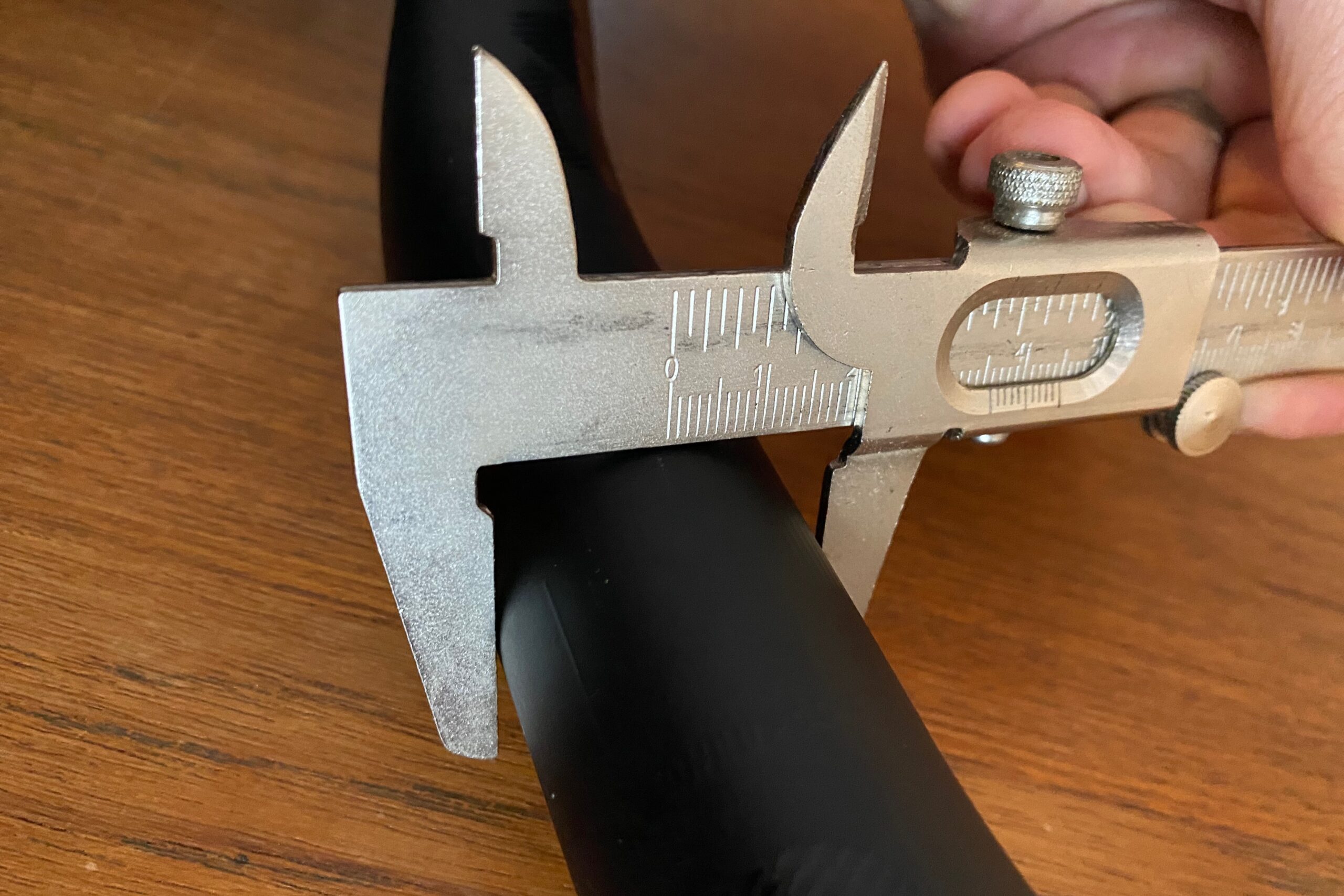
Clamp Diameter
Mountain bike handlebars come in either 31.8mm or 35mm clamp diameters, and quite a few are offered in both sizes. If you’re getting a new handlebar to replace your existing one (and you don’t want to replace your stem too), then you’ll want to be sure you get the same clamp size. The size is typically printed somewhere on the handlebar, usually in the clamp zone that gets covered by the stem, but if not, you can measure the diameter with a caliper.
For many years, the 31.8mm clamp diameter was considered the “standard” until several brands started making bars and stems with a 35mm clamp interface. Initially, the move to 35mm clamp diameters was to increase both the stiffness of the bar/stem interface and the handlebars themselves, and the general perception was that all 35mm clamp bars were stiffer than 31.8mm. While that may have been true for a short time, it is by no means a hard and fast rule and we’d call it an oversimplification. These days, the stiffness of a bar is dictated more by its design and construction than by its clamp diameter, and there are super stiff and very compliant bars in both sizes.
That said, we did notice in the results of our lab testing in the sample of bars we tested, that the average stiffness of those with a 35mm clamp was, in fact, just slightly higher than those with a 31.8mm clamp. Again, this is a broad generalization, but a notable trend nonetheless. Regardless of clamp size, most riders should be able to find a handlebar that suits their preferences.
Stem
The stem of your mountain bike is a pretty straightforward component that simply attaches your handlebar to your fork’s steerer tube. As such, along with your handlebar, your stem is part of a system that is used to control your bike. Mountain bike stems come in a wide array of shapes and sizes that can play a role in your bike fit (bar height and reach), and varying levels of stiffness that can have a minor impact on the responsiveness of your handling. Depending on the stem, some can have a bit of flex, while others are ultra-stiff, so that can be a factor that’s worth considering when upgrading your handlebar, especially if you’re going to a different clamp size and need to purchase a new stem anyway.
On the topic of bike fit, altering the length of your stem is an easy way to effectively increase or decrease the length of your reach, which can play a large role in your comfort as well as your bike’s handling.
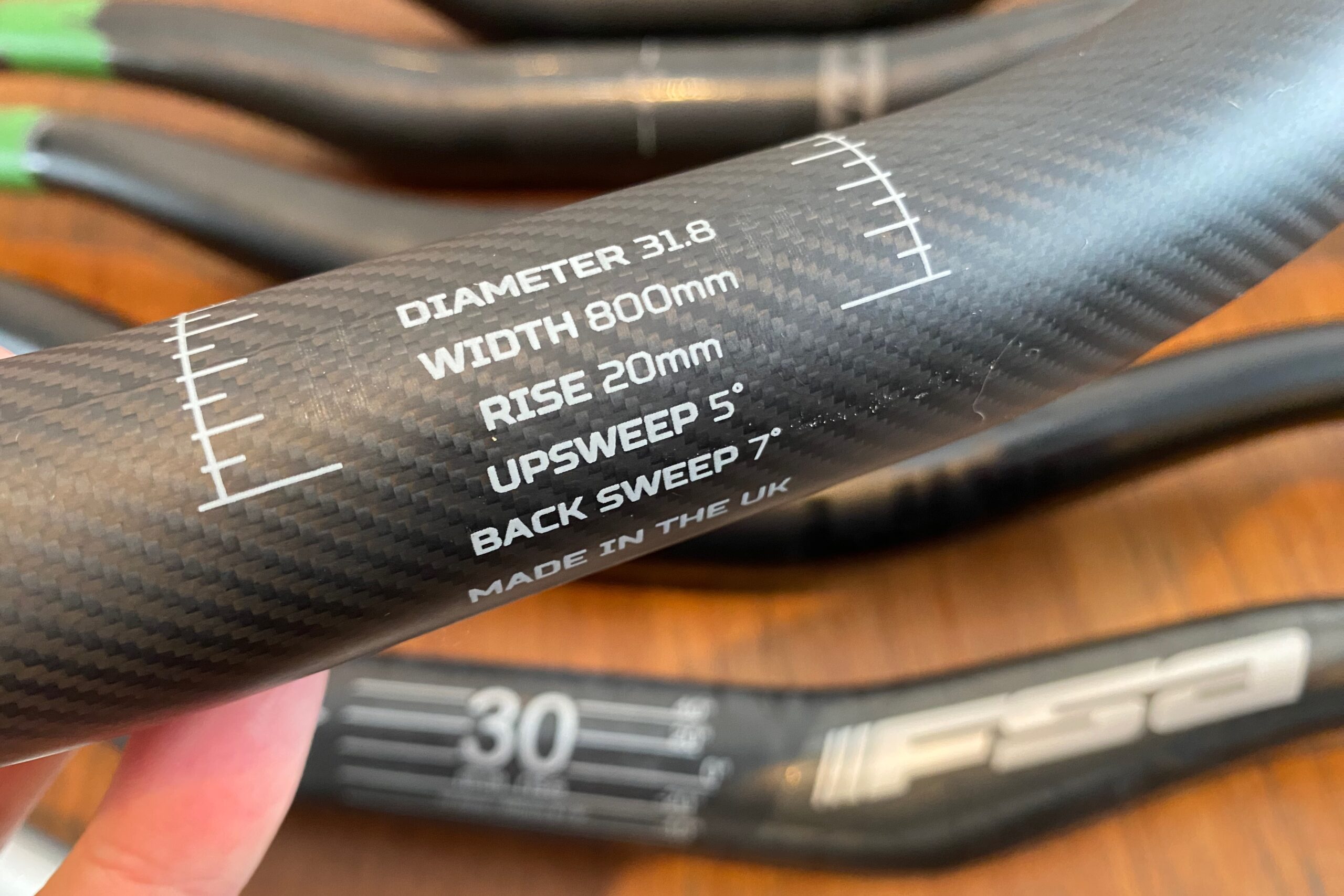
Geometry
Mountain bike handlebars come in a vast assortment of rises, sweeps, and widths, all of which can play a role in your body position, wrist alignment, and overall comfort on the bike. And, by making changes to any of those dimensions, you can adjust the ergonomics and fit of your cockpit to dial it into your specific needs.
Width
Over the past couple of decades, mountain bike handlebars have (thankfully) trended wider which has helped improve both stability and handling leverage for our increasingly capable bikes. While it varies somewhat by brand and model, most handlebars for trail or gravity riding come in the neighborhood of 780mm to 800mm in their uncut, stock width. Handlebars on XC bikes tend to be a bit narrower, and the lightweight Race Face Next SL is a good example that comes in a 740mm width. While the stock width of a handlebar might be a great fit for some riders, our bodies come in all different shapes and sizes, and more often than not, most riders could benefit from trimming a new handlebar to a more appropriate width to get a better fit.

Handlebars that are too narrow can result in less stability and control, while bars that are too wide can stretch your arms out too far and negatively impact your handling or comfort in other ways. Determining the right width can be a little tricky, but if you have a handlebar that you already know is a good fit for you, it could be as easy as measuring that one and trimming your new bar to match. Otherwise, we suggest using a calculated approach because cutting your handlebar is permanent. Remember, you can always make it narrower, but you can’t put material back on, so start slowly unless you are confident that it is right.
Handlebar manufacturers anticipate that their bars will be getting trimmed and most come marked with measurement lines on the ends to make it a little easier. It isn’t too difficult to trim a handlebar on your own (there are some great tips online), but if you are unsure or don’t have the tools, any local bike shop should be able to help you out.

Rise
The rise of a handlebar refers to how high a handlebar rises over its length out toward both ends and it is typically measured in millimeters. Rise is relatively important to consider as your handlebar height can have a large impact on your body position, weight distribution, and overall comfort on the bike. For this reason, many handlebars are offered in several rise options to suit varying needs and preferences, while others are only offered in a single rise.
Like anything else, there is no one-rise-fits-all, and what works best is typically a matter of personal preference or potentially the type of bike that you’re riding. If, for example, you feel excessive pressure on your hands while riding, it could be that your handlebar is a little low and that pressure could be relieved by using a bar with a higher rise that shifts your body position slightly more upright. Conversely, if the front end of your bike feels too high, prone to wandering, or you’re looping out on steep climbs, lowering your bar height with a lower-rise handlebar could help fix the problem. It’s also worth mentioning that adjusting the position of the spacers above or below the stem can have a similar effect on your bar height.
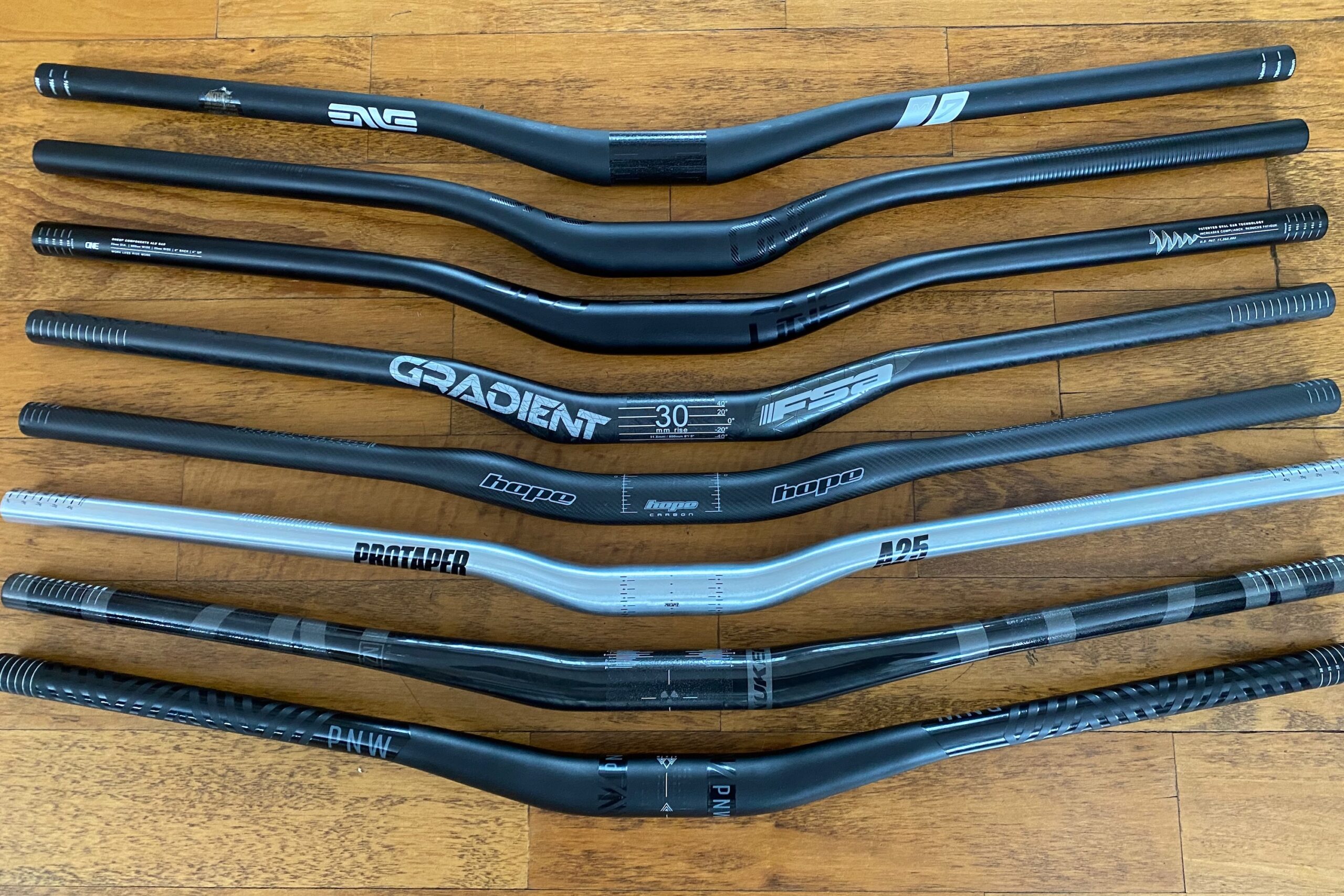
The right amount of rise may also be influenced by the type of riding you’re doing. Cross-country racers who prioritize pedaling speed and efficiency will often ride in a more aggressive, forward-leaning position, so it’s not uncommon to see flat or 10mm rise bars on lightweight XC bikes. Conversely, those who ride super steep terrain frequently will often opt for a higher-rise handlebar to raise up the front end of the bike and help prevent their body weight from being too far forward while descending steeper pitches. Again preferences vary, but finding the right rise for you is an important aspect of having your cockpit setup dialed in for comfort and performance.
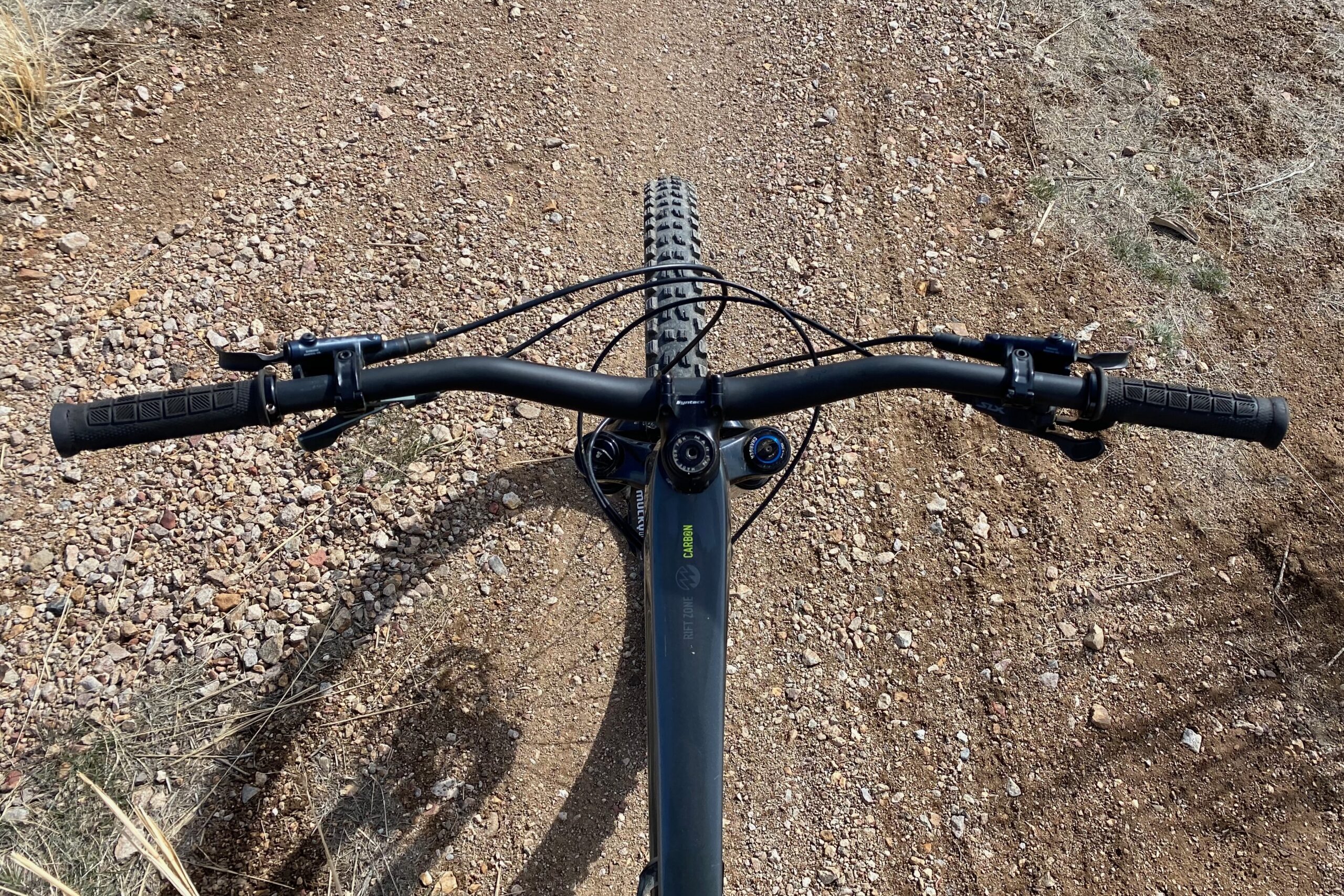
Back Sweep and Upsweep
Moving out from the center of the handlebar, the ends of handlebars are angled both up and back, and these angles are referred to as upsweep and back sweep. These angles are intended to provide better alignment of the hands and wrists when gripping the handlebar in the riding position. There aren’t really “standard” upsweep and back sweep angles, although the sweet spot for most riders is around 8° or 9° back and 4° or 5° up as evidenced by the fact that the majority of handlebars on the market fall into that range. There are outliers, of course, like the Hope Carbon Handlebar with a slightly more aggressive 7° back sweep or the PNW Range Gen 3 which has a somewhat more relaxed 10° back sweep.
Some riders can benefit from more improved ergonomics and wrist alignment offered by handlebars that have more back sweep than the normal range mentioned above, and fortunately, a few brands offer products to meet that need. One such handlebar is the SQlab 30X Carbon (or aluminum) which can be purchased with either 12° or 16° of back sweep. While that much back sweep isn’t necessarily ideal for everyone, it may be exactly what some riders need to ride more comfortably. It is worth noting that increasing back sweep effectively shortens reach, so those opting for more extreme angles like 12° or 16° may need to consider adjusting stem length to compensate.

Bar Roll
Directly related to back sweep and upsweep is bar roll. When setting up your handlebar, you want to position it so that the back sweep and upsweep are aligned in the position that feels best for you, and that is done by “rolling” the handlebar forward or back in the stem. Even slight changes to bar roll can play a big part in your wrist alignment and how a handlebar feels against your palms. Changes to bar roll are quite easy to make, so this is relatively easy to experiment with to find out what works best. Just be sure to reposition your controls and grips to the correct angles if you are making changes to the bar roll.

Control Setup
Setting up your controls (shifters and brake levers) properly can also impact your wrist alignment and impact your comfort. Ideally, you want your shifter paddles and dropper lever to not interfere with your thumb while gripping the handlebar but still be close enough that you don’t have to reach excessively to press on them. Similarly, the lateral position and reach of your brake levers should be adjusted to suit the length of your fingers so that you can reach them easily. And, let’s not forget your choice of mountain bike grips as that can impact your comfort as well.
The angle of your brake levers is arguably the most important here as it is most likely to impact how your wrists are aligned when gripping the handlebar and reaching for the levers. If your levers are too flat or too steep it can cause your wrists to bend too much in one way or the other. Of course, what works best is a matter of personal preference and may also be dictated by the type of riding that you’re doing. Just like bar roll, adjusting the position and angles of your controls is quick and easy, so trying different things to dial it in is pretty straightforward.
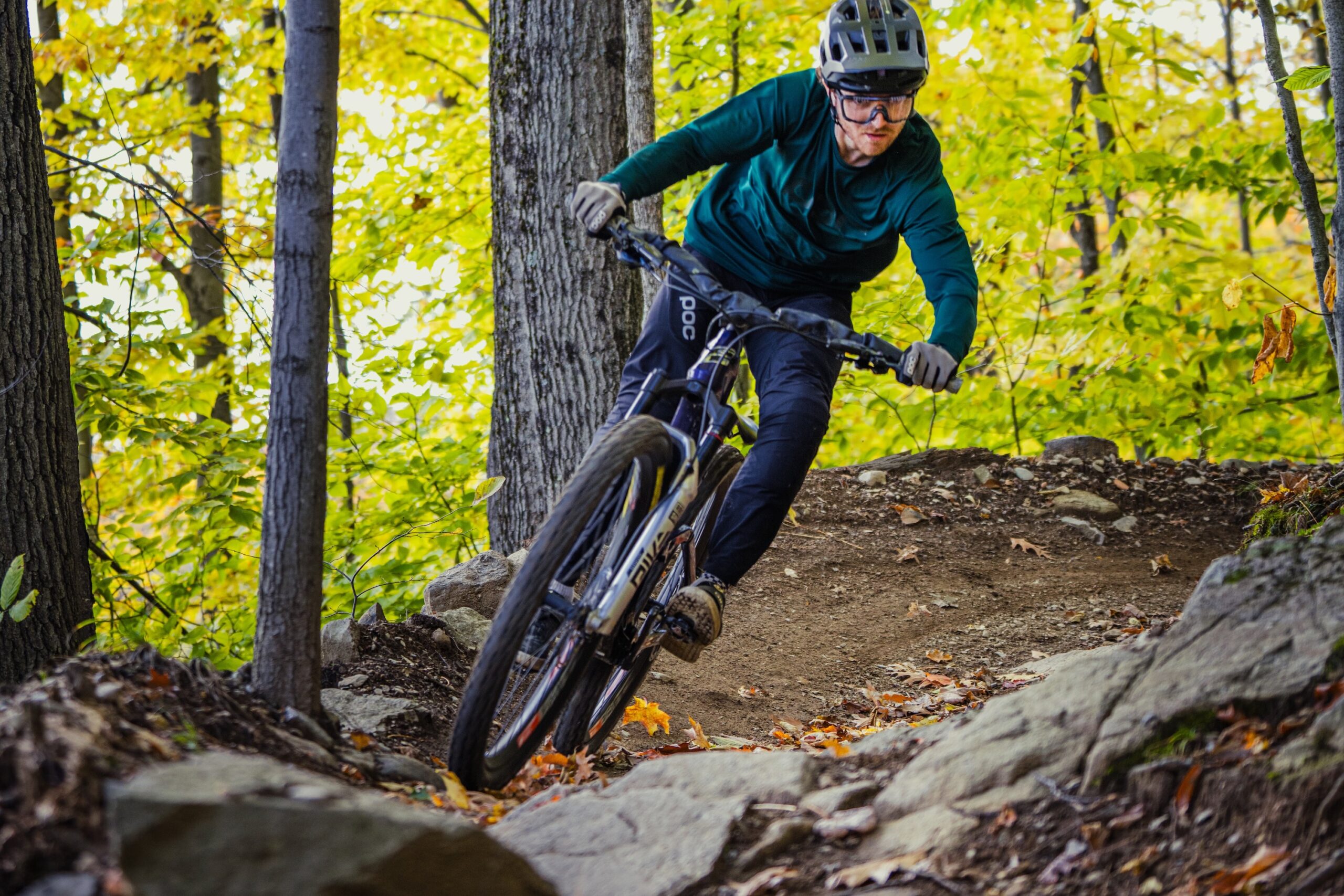
Stiffness vs Compliance
Compliance is a popular buzzword in the cycling industry that is used to describe components that provide some forgiveness through flex, and it is used by many handlebar manufacturers to characterize the performance of their products. Compliance is essentially the opposite of stiffness, and it refers to a material or object’s ability to flex under load. While flex may not sound like the most desirable trait in a handlebar, compliance can work to absorb some of the forces from impact which can be beneficial and improve rider comfort.
Advancements in materials and construction methods have allowed brands to tune handlebars to achieve desired performance characteristics whether that’s super stiff, very compliant, or somewhere in between. Without an industry-wide compliance test “standard”, however, it’s hard to know where different handlebars line up on the stiffness/compliance scale compared to each other.
So, in 2023, we partnered with Faction Bike Studio to do a first-of-its-kind mountain bike handlebar compliance test. We tested 42 different handlebars in Faction’s lab with a standardized flex test to see how they vary in terms of stiffness and compliance (see the graph below to compare), and then we did some blind rider testing to see if the lab test results are noticeable in use and how that translates out on the trail.

As you can see, there are some pretty dramatic differences in terms of stiffness, and in our testing, we determined that those differences are, in fact, noticeable while riding. Believe it or not, there are some handlebars that can provide enhanced comfort through impact and vibration absorption, but, just like anything else, how stiff or compliant your handlebar should be comes down to rider preference.
Stiff handlebars are known for being super precise and provide responsive handling, but sometimes it comes at the cost of comfort. On the other hand, compliant handlebars are known for providing more comfort, but sometimes at the cost of handling precision. Handlebars in the middle of the stiffness scale will typically provide the most balanced characteristics, where they provide a little extra comfort without sacrificing much in terms of handling.

Many modern handlebars, particularly those made from carbon fiber, are being constructed with specific layups that allow for some vertical compliance to absorb impact while remaining horizontally stiff for handling and control. Those performance traits can be hard to balance, but some brands and models of handlebars are doing it quite effectively. Carbon fiber, and particularly all of the interfaces of composite structures, does a better job of absorbing vibration and helping to dampen high-frequency feedback that may otherwise be transferred to the hands compared to other materials. But, as you can see in the graph above, many of the stiffest bars we tested also happen to be made from carbon. Still, one of our favorite carbon handlebars is the OneUp Components Carbon as its unique ovalized shape and carbon construction provide an amazing balance of compliance, vibration absorption, and handling precision.
Just like carbon handlebars, those made from aluminum vary pretty dramatically in terms of stiffness/compliance, but on average, we found them to be slightly more compliant in the lab testing. Regardless, there is a big range from super stiff to more compliant which can be seen in the graph above. Six of the ten most compliant bars are aluminum and two of the ten stiffest bars are aluminum, so you have the option to choose your preferred stiffness. It’s worth noting, however, that aluminum doesn’t absorb high-frequency vibration quite as well as carbon fiber can, generally speaking, although the bars on the more compliant end of the spectrum do help absorb bigger impacts quite effectively.
Titanium is much less common as a material for handlebars, mostly because it is more expensive, but it is known for providing a unique, comfortable ride feel when used as a frame-building material. This translates pretty directly to the handlebar application, and our lab testing showed that the three titanium models we tested were the most compliant compared to aluminum or carbon fiber. On the trail, that difference is noticeable and they definitely do absorb some of the impact forces from larger hits. And, while we found the handling to feel a tiny bit vague initially, it didn’t take long at all to get used to it. The raw titanium also looks awesome, which doesn’t hurt either.
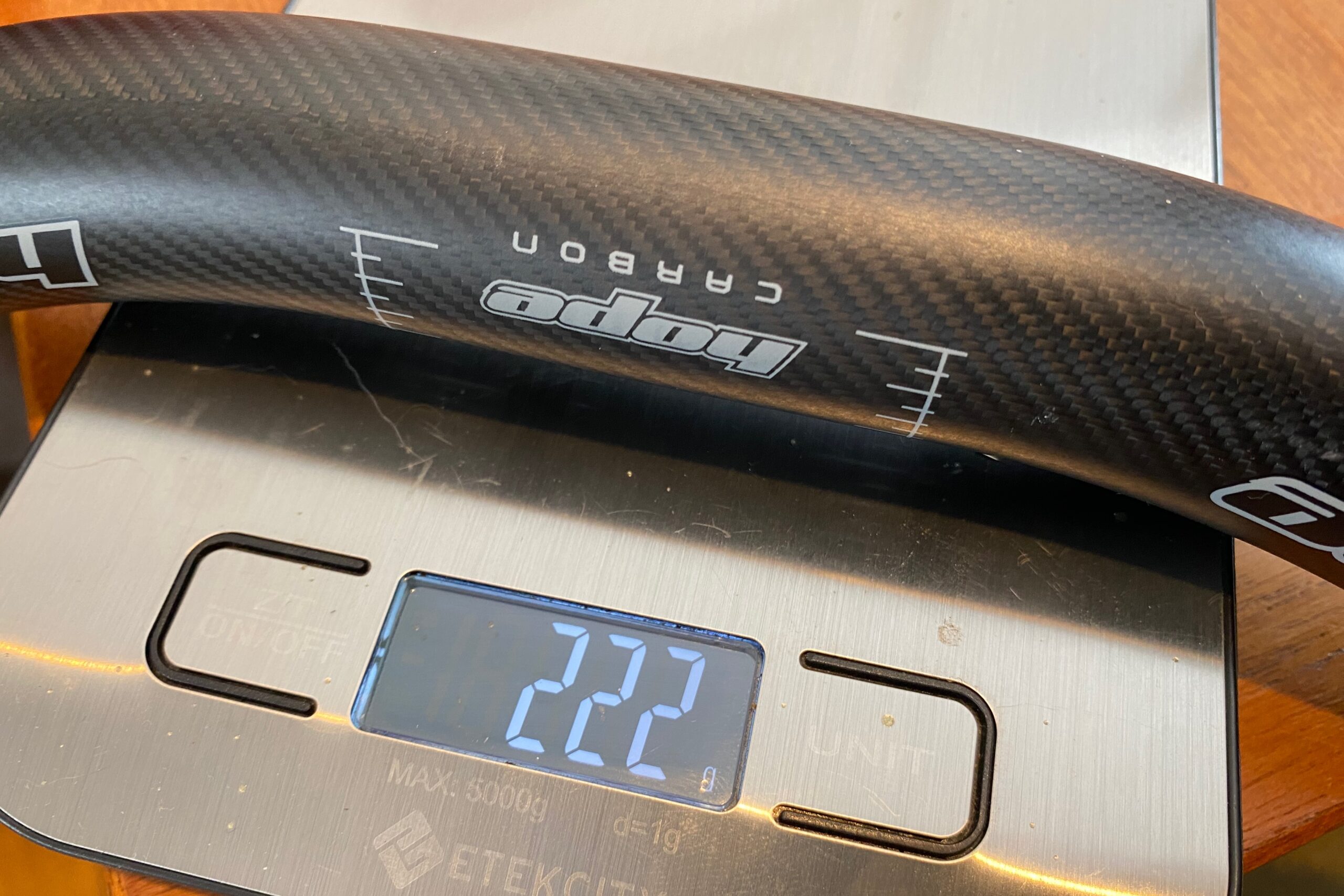
Weight
The weight of a handlebar probably shouldn’t be the most important factor in deciding what to buy, but for the weight-conscious among us, it is possible to save weight on your bike with an upgrade if you choose. With most aluminum handlebars weighing in around 300g to 340g and most carbon bars ranging from around 200g to 250g, it’s possible to reduce the overall weight of your bike by around 100g (3.5 oz) or so. While that may seem insignificant to many riders, there are plenty of folks who might appreciate the benefits of having a lighter overall bike weight, and compared to some other components, the price-to-weight difference between a carbon bar and an aluminum one is easier to stomach.
For those riders looking to save the most weight on a light XC race bike, for example, there are several super light handlebars on the market. The lightest one we’ve tested is the Race Face Next SL which comes in at a scant 167g at its untrimmed 740mm width. While that width won’t appeal to everyone, it is well chosen for the XC application where bars tend to be a bit narrower than those used by trail and enduro/gravity riders. Moving up slightly in weight, many of the wider, burlier carbon bars are still very light with models like the Hope Carbon handlebar (222g), Oneup Carbon (228g), Chromag BZA (230g), and the FSA Gradient carbon (237g) weighing shockingly little compared to comparably sized aluminum options.
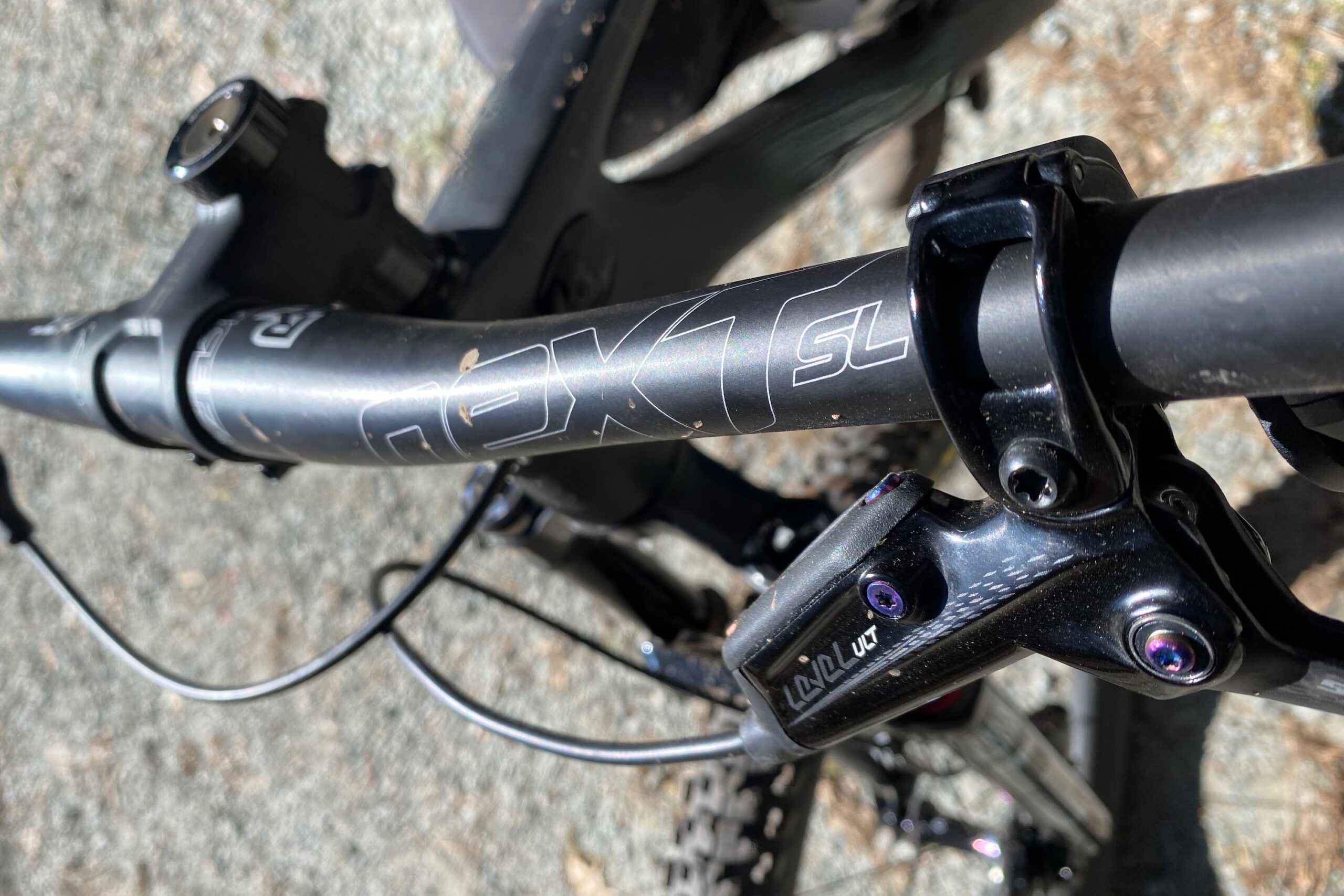
Value
You don’t have to spend a lot to get a handlebar that will be a performance upgrade over the stock aluminum handlebars that come on a lot of complete mountain bikes. The aluminum models we tested range in price from $69 to $109, and there are plenty of other options on the market that are priced similarly and will outperform the basic options that many manufacturers spec on bikes to save money. The cost of a handlebar rises as the material gets fancier and the weight comes down, and carbon fiber handlebars fall in a price range of around $150 to $200. While that is obviously more expensive than the aluminum options, the weight savings is fairly significant and we feel the performance helps to justify the higher price tag. Going up a price level, niche products made from exotic materials like Titanium or that have specific features like extra back sweep seem to command more money. While a Titanium handlebar or 12-16° back sweep won’t appeal to everyone, they exist for those who need or want them, just know that you’ll be paying a little extra to get it.
Frequently Asked Questions
There are a number of reasons to upgrade your mountain bike handlebar. First, unless you bought a high-end complete bike, the stock handlebars that come on most bikes are super basic aluminum options chosen for their cost savings and not their performance. Sure they work fine, but just about any aftermarket handlebar will perform better.
Second, you can alter the fit and, therefore, your comfort on the bike by getting a handlebar that has a shape that works well for you. By altering the rise, sweeps, and width of your handlebar, you can dial it in perfectly for your riding style, body position, wrist alignment, etc, for better ergonomics, and ultimately improved comfort and control of your bike.
Third, handlebars vary dramatically in terms of stiffness, so it’s possible to get one that fits your desired performance characteristics. Want something stiff and precise, compliant and forgiving, or something in between? Well, there are lots of options to choose from. And, just like the right fit can improve comfort, you can also improve hand, wrist, and upper body comfort by using some of the more compliant handlebars that help absorb impact and vibration.
Fourth, you can also reduce the overall weight of your bike by switching from aluminum to carbon fiber. That won’t matter to everyone, but it is among the more cost-effective ways to shave weight off your bike.
While it probably won’t be worth it for everyone, we think that the performance benefits justify the asking price of carbon or Titanium handlebars for serious riders. For carbon bars, the weight savings is notable, and to us, carbon’s ability to absorb high-frequency vibration is definitely noticeable in back-to-back comparisons (though it varies somewhat by the model in question). Also, the ability for manufacturers to tune carbon handlebars to perform in specific ways means you can probably find a bar that meets your needs and wants and changes the overall ride feel of your bike. Realistically, a nice carbon handlebar costs about the same as a new set of mountain bike tires (at retail prices), and it will last a heck of a lot longer, so we feel it is money well spent.
Titanium handlebars are among the most expensive on the market, but they can also provide tangible benefits for some riders. Given their impressive levels of compliance, they can be a great option for those seeking a more forgiving ride feel that helps prevent arm pump or your hands from going numb.
Roost’s Titanium handlebars proved to be the most compliant of all the handlebars we tested in Faction Bike Studio’s lab by roughly 30% compared to the average compliance of the other handlebars made from aluminum or carbon fiber. This was also quite noticeable on the trail as the Roost bars provided a comfortable ride quality and helped take the edge off larger impacts in particular.
Several aluminum handlebars, but most notably the ProTaper A25 and A50 models were almost as compliant as the Roost Titanium bars in the lab testing and provided a similar ride feel. Surprisingly, however, some of the carbon handlebars that fall in the middle of the compliance spectrum provide a more damp, muted feel due to carbon’s ability to absorb high-frequency vibration more effectively.
The stiffest handlebar we tested is the Nukeproof Horizon V2 Carbon (35mm clamp, 12mm rise). In fact, four of the ten stiffest bars we tested were Nukeproof Horizon V2 carbon models in various clamp sizes and rises. These are burly handlebars made for precision on rough DH tracks at high speeds. Not to be outdone, however, three FSA Gradient Carbon handlebars are in the top ten stiffest handlebars too. And, two Chromag OSX Aluminum models also compete among the stiffest bars we tested in Faction’s lab. So, if you prioritize stiffness, you’ve got options.
If you suffer from hand numbness, wrist discomfort, or arm pump while riding, a more compliant handlebar can often help reduce the amount of feedback and vibration transmitted through the bars and into your hands and upper body. Of the models we tested, the Roost Titanium bars were the most compliant in the lab testing we did with Faction Bike Studio. Not far behind was the ProTaper A25 Aluminum handlebar, which also costs significantly less. That said, we’ve found some of the carbon bars that fall in the middle of the stiffness/compliance spectrum, like the OneUp Components Carbon, to provide excellent comfort due to carbon’s ability to mute high-frequency vibration that would otherwise be transferred to the hands.
If you’re upgrading or replacing your handlebar and you don’t want to purchase a new stem, then you’ll want to get the same size you already have, either 31.8mm or 35mm. Often, the clamp size is printed somewhere on the handlebar, so take a look around and see if you can find it. Hint: it may be hidden under the stem in the clamp area, so you may need to remove it from the stem to find this info. If you don’t see it printed anywhere, then using a caliper, if you have one, is an easy way to measure the diameter. Otherwise, bring your bike to a local bike shop, they should be able to help you out.
Based on the results of the lab testing done at Faction Bike Studio, we found that on average, 35mm clamp diameter handlebars are slightly stiffer than 31.8mm. And, that those differences are slightly more pronounced in Aluminum handlebars than in carbon fiber. Still, those are just averages, and the differences in average stiffness are relatively minimal. Given the amount of variability in terms of stiffness, regardless of clamp diameter, it should not be assumed that a particular handlebar will be stiffer than another based on clamp size alone. The brand, model, material, and rise also play a role in a handlebar’s stiffness.
Finding the ideal rise can be tricky, but having your handlebar at the right height is critical for rider comfort and also performance. If you feel too much pressure on your hands, then adding rise can often help. Similarly, if you find your weight too far forward on steep descents, adding rise may also be beneficial. On the flip side, if you find that your body position is too casual or upright most of the time or that there isn’t enough weight on the front end of the bike, reducing your rise might help.
One way to experiment without dropping cash on a new handlebar is to move the stem up or down by adjusting the position of the spacers above or below it. This effectively changes the height of your handlebar and gives you an idea if more or less rise would be helpful. If you’ve already maxed out or bottomed out your stem height and still feel the need to go higher or lower, then choosing a bar with more or less rise could be the solution.
Related Content
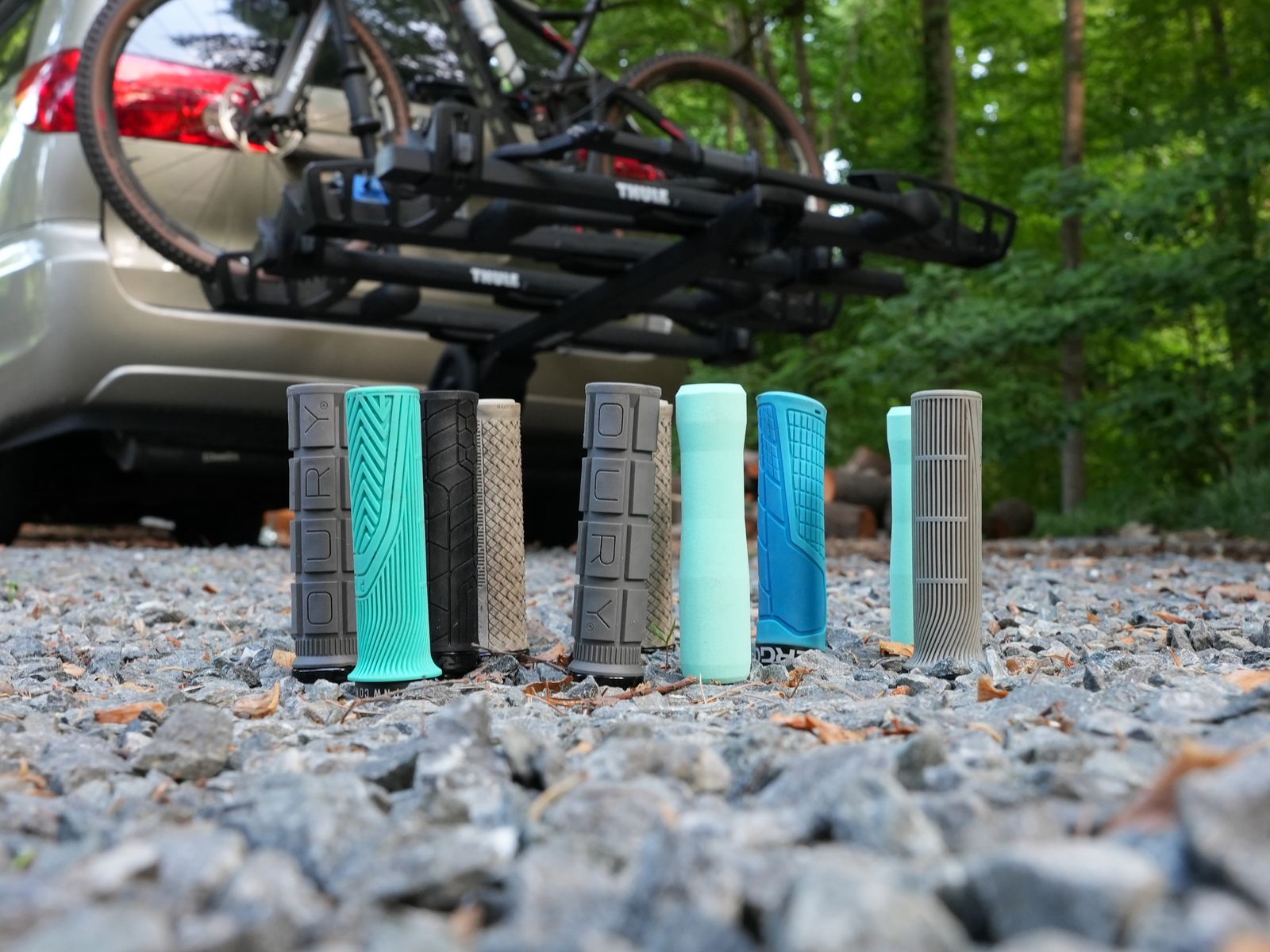
Best Mountain Bike Grips – Find the right MTB grip to smooth out your ride
Mountain bike grips seem simple, but in reality, an MTB grip is going to be the part of the mountain bike that you spend the…

The Best Mountain Bike Shoes of 2024
As a critical connection between you and your bike, finding the best mountain bike shoes is very important. Good shoes provide stability, control, and protection…
